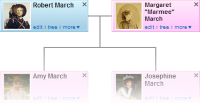


About The Billiot Family This Billiot family tree centers around the ancestors and descendants of Israel Billiot and his wife Aline Hornsby Billiot, and their seven children born in the early 20th century - 1913 to 1938. It is sourced with original records and oral histories wherever possible to give it credibility as a scholarly family history of record. This family tree is constantly expanding as more detailed and accurate information is confirmed. There are many branches of this Billiot tree to research dating back to original family members in 1710 and by marriage to 1662.
Currently, much of the information herein follows the lineage of Israel and Aline's eldest son Elwood Abby Billiot, known as Woody, and his wife Elizabeth Antoinette Francis Billiot, known as Tootie, and their 12 children, 33 grandchildren and the extended family. It follows the male side of Woody's family lineage back to the late 1710. The blood line includes French, Indian, Italian, Cajun, Black, German and English. A mixed breed indeed.
At some point, it is hopeful that biographical information, and even more so, stories about the entire Billiot family will be published. Keep digging and drilling down here and elsewhere and you will find evidence our ancestors were Indian slaves as well as owners of slaves, sugarcane farmers, laborers, trappers, land owners and even nobility if you go way back.
But this story starts with Israel and Aline.
What was it like in the virtually isolated community of Grand Caillou, LA at the turn of the century in 1900 where Isarel and Aline were growing up as young children? Did they identify themselves as Houma Indians as their lineage dictates they are? As an adult, like most everyone down the bayou, Israel was a fur trapper, and later a distributor of produce and seafood in New Orleans. He and his wife Aline Hornsby had seven children, Elwood, Leola, Clarence, Beatrice, Eleanor, Priscilla and Ann and adopted or otherwise raised two other children - Albert Smith and Edna Trahan. The family for the most part lived together until the mid-1960s and shared financial resources and burdens, along with social occasions and events that were joyous, sad and often dramatic. Together they witnessed World War I, the Great Flood of 1927, The Depression, World War II, and the Civil Rights movement. They, themselves were victims of segregation where Indians were not allowed into certain restaurants, and they were not allowed into public schools in the early part of the 20th century.
One thing is clear: Israel was the leader of the family and did everything he could to help his family prosper.
But why did Israel move the family to New Orleans in 1938? What was it like to have Woody's large growing family, along with Clarence's wife Mickey and Israel's girls live together on Ave. F on the Westbank of New Orleans? How were the bills paid? Who cooked? Where did the kids go to school? Why didn't the kids pick up the Cajun French language? What is the story behind Woody building a crab processing plant known by the family as "The Factory." And if we go further back, what were the family's beginnings?
If you think about it, an amazing story is waiting to be told.
By the way, the best way to see the family as a group is to go to the tool bar and click on Tree/Printable/DecorativeFanCharts/ and then click on the 6th generation fan chart, which creates a PDF file. Use different family names to see different charts. The charts allow you to see how confusing our family tree gets because of marriages by the same people to two or more sides of the family. It also allows you to see where information is missing so you can help fill in the blanks. Bon Chance!